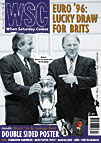 Robert Rea fears that an American-style system may be about to spread to English football
Robert Rea fears that an American-style system may be about to spread to English football
“Manchester United chairman Martin Edwards has finally completed the controversial multi-million pound deal to move his club to Milton Keynes. The first game at their new ground, the Super Bowl, will be at the beginning of next season against Warrington Wednesday.’’
Unthinkable, preposterous, even. That sort of thing may go on across the Atlantic, but as I explained to my American brother-in-law as we watched the owner of the Cleveland Browns sign the deal which took his team to the warmer and more alliterative city of Baltimore, it couldn’t happen here. Not in soccer. The fans wouldn’t stand for it. It wouldn’t be allowed.
The next day, there it was in the papers. Some Irish businessmen were making an incomprehensible attempt to whisk Wimbledon off to the banks of the Liffey to become, no doubt, the Dublin Diehards or some such. I mean, Selhurst Park is far enough away from Merton, but Dublin? It would be the first time a top-flight club had moved from one town to another, let alone a different country.
Of course, we all know it won’t happen. It’s too ridiculous. You couldn’t have an English League club playing home games in Ireland (although Wales is OK, apparently). But what if somewhere in England, somewhere with a large-ish population and a vacancy for a top professional team (Milton Keynes, say), made Sam Hammam a serious offer? A rent-free super-stadium and a bundle of used tenners in a brown paper bag for moving Midlands-wards? It’d be out with the packing crates before you could say Pickfords.
Now whether Wimbledon spend the next few years wandering through the wilds of South London or relocate to virgin territory may not be of any great moment. After all, they’re not exactly deeply-rooted in their home soil. But if one club sets off for pastures new, what’s to stop the rest of them doing the same?
A glance at the manic merry-go-round afflicting North American football, baseball, basketball and ice hockey shows us where we could end up if we’re not careful. Since the war, 45 major clubs have switched cities, some of them several times.
The basketball team the Tri-Cities Hawks, for instance, moved north to Milwaukee, south to St Louis, and then on to Atlanta, all within eighteen years. The ill-fated Dallas Texans football team were shifted to Baltimore (where they became the Colts and later moved to Indianapolis) after their owners went bankrupt. A few years later, the Texans were reformed – only to be carted off to Kansas City and renamed the Chiefs.
Franchise owners’ feet, especially in the National Football League, are getting itchier. In the last two years, four NFL teams have moved house. Los Angeles, which used to boast the Rams and the Raiders, lost both within months. Other teams, like the Philadelphia Eagles (who’ve spent just one of their 62 years outside the City of Brotherly Love), are threatening to leave unless their host cities build grand new stadia for them.
With dozens of places keen to get their hands on an NFL team, and the disenfranchised towns like LA willing to pay almost anything to regain their former NFL status, more moves are expected in the near future.
Unsurprisingly it’s money that is fuelling this desire for a change of scenery. Owners, facing both soaring players’ salaries and the realization that they’ve already creamed as much cash out of TV rights as the broadcasters are prepared to pay, are looking for new ways to make a buck out of the game.
Replacing their old, dilapidated (by American standards anyway), high-maintenance stadiums with new custom-built ones stuffed with hyper-expensive luxury boxes, at no cost and with plenty of tax breaks thrown in, has become the popular option. So popular that NFL clubs are willing to screw their fans, abandon years of tradition, brave legal battles and hike themselves halfway across the country to take it.
The possibility of British soccer clubs following suit seems remote. But to some extent it’s already happening. There are the forced, ‘temporary’ moves – Wimbledon to Croydon, Bristol Rovers to Bath. And there are the moves to hi-tech new stadia – Millwall, Middlesbrough (albeit not far from their old homes). Not NFL-style moves, to be sure, not different-city halfway-across-the-country-and-sod-the-supporters moves. But moves all the same.
The aspect of the American experience which should raise concern is this – if the clubs want to move, there’s nothing to stop them doing it. Pressure from the fans? Cleveland’s supporters were among the most loyal and vocal in the NFL, but their mass protests were simply ignored. The law? The Browns are facing sheaves of injunctions and legal liabilities involving millions of dollars, but they’re pressing ahead regardless. Popular opinion? The moves are almost universally condemned in the US press, but not one has been halted as a result.
In America, the only obstacle to NFL owners moving their teams is the NFL itself. The NFL can stop a move by a majority vote of its governing body, which consists of (and there’s the rub) all the teams’ owners. In practice, the NFL has allowed individual owners to do largely what they want.
The lesson for the FA, if it wants to ensure it avoids going down the same road, is that it can’t afford to be so lax. When businessmen scheme of moving Wimbledon to Dublin (or Man Utd to Milton Keynes), then however unlikely those schemes are, the FA should say loudly, clearly, and immediately, that they will be opposed.
From WSC 108 February 1996. What was happening this month